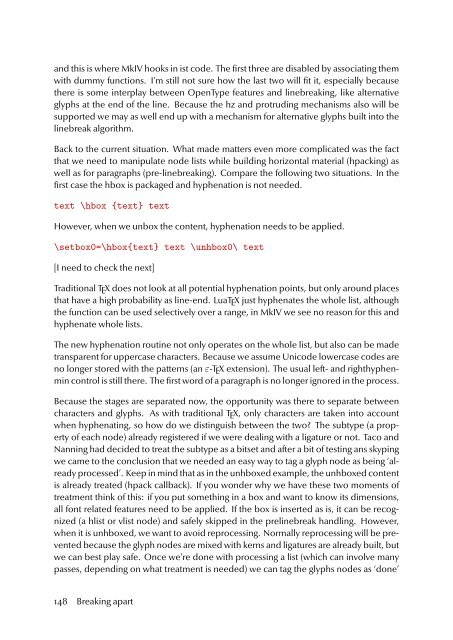The history of luaTEX 2006–2009 / v 0.50 - Pragma ADE
The history of luaTEX 2006–2009 / v 0.50 - Pragma ADE
The history of luaTEX 2006–2009 / v 0.50 - Pragma ADE
Create successful ePaper yourself
Turn your PDF publications into a flip-book with our unique Google optimized e-Paper software.
and this is where MkIV hooks in ist code. <strong>The</strong> rst three are disabled by associating them<br />
with dummy functions. I'm still not sure how the last two will t it, especially because<br />
there is some interplay between OpenType features and linebreaking, like alternative<br />
glyphs at the end <strong>of</strong> the line. Because the hz and protruding mechanisms also will be<br />
supported we may as well end up with a mechanism for alternative glyphs built into the<br />
linebreak algorithm.<br />
Back to the current situation. What made matters even more complicated was the fact<br />
that we need to manipulate node lists while building horizontal material (hpacking) as<br />
well as for paragraphs (pre-linebreaking). Compare the following two situations. In the<br />
rst case the hbox is packaged and hyphenation is not needed.<br />
text \hbox {text} text<br />
However, when we unbox the content, hyphenation needs to be applied.<br />
\setbox0=\hbox{text} text \unhbox0\ text<br />
[I need to check the next]<br />
Traditional TEX does not look at all potential hyphenation points, but only around places<br />
that have a high probability as line-end. LuaTEX just hyphenates the whole list, although<br />
the function can be used selectively over a range, in MkIV we see no reason for this and<br />
hyphenate whole lists.<br />
<strong>The</strong> new hyphenation routine not only operates on the whole list, but also can be made<br />
transparent for uppercase characters. Because we assume Unicode lowercase codes are<br />
no longer stored with the patterns (an ε-TEX extension). <strong>The</strong> usual left- and righthyphenmin<br />
control is still there. <strong>The</strong> rst word <strong>of</strong> a paragraph is no longer ignored in the process.<br />
Because the stages are separated now, the opportunity was there to separate between<br />
characters and glyphs. As with traditional TEX, only characters are taken into account<br />
when hyphenating, so how do we distinguish between the two? <strong>The</strong> subtype (a property<br />
<strong>of</strong> each node) already registered if we were dealing with a ligature or not. Taco and<br />
Nanning had decided to treat the subtype as a bitset and after a bit <strong>of</strong> testing ans skyping<br />
we came to the conclusion that we needed an easy way to tag a glyph node as being ‘already<br />
processed’. Keep in mind that as in the unhboxed example, the unhboxed content<br />
is already treated (hpack callback). If you wonder why we have these two moments <strong>of</strong><br />
treatment think <strong>of</strong> this: if you put something in a box and want to know its dimensions,<br />
all font related features need to be applied. If the box is inserted as is, it can be recognized<br />
(a hlist or vlist node) and safely skipped in the prelinebreak handling. However,<br />
when it is unhboxed, we want to avoid reprocessing. Normally reprocessing will be prevented<br />
because the glyph nodes are mixed with kerns and ligatures are already built, but<br />
we can best play safe. Once we're done with processing a list (which can involve many<br />
passes, depending on what treatment is needed) we can tag the glyphs nodes as ‘done’<br />
148 Breaking apart
















